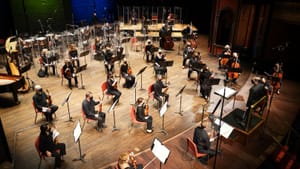A musical commentary
The Delaware Symphony Orchestra presents its Classics Series VI

To close out this season—so different from all the rest—conductor David Amado and the Delaware Symphony reverted to a DSO tradition, opening their final spring concert with a work by the recipient of the annual A.I. duPont Composer’s Award. Established in 1985, it recognizes distinguished living American composers or conductors, underlining the DSO’s commitment to contemporary music. The 2021 recipient, joining luminaries including Philip Glass, Jennifer Higdon, and André Previn, is composer Claude Baker.
Baker (b. 1948) is Professor Emeritus of composition at Indiana University (Bloomington) and has been highly honored in a career that features scores of performances and commissions from national and international orchestras and chamber groups. He was composer-in-residence with the St. Louis Symphony for eight years (1991-99), an exceptionally long and distinguished tenure. From this substantial oeuvre, the DSO chose to honor Baker by playing his mesmerizing and frequently mysterious Tre Canzone.
The essence of poetic texts
The composer took favorite songs by other composers from different eras for the work’s three movements: “after Baude Cordier” (late Middle Ages), “after Claudio Monteverdi” (Renaissance), and “after Clément Janequin” (early Baroque). Then, following a 16th-century Italian tradition, Baker restructured each song into something new. In his beautifully written program notes, the composer says that he saw these preexisting works “as points of departure for my own musical ideas,” attempting to capture the essence of their poetic texts with a “non-vocal commentary” that alludes to (but does not duplicate) the original songs.
Baker wrote the work for a very large orchestra, taking advantage of the colors created by that swarm of instruments, and Amado – who was with the St. Louis Symphony when Baker was there – has conducted the original version. But Covid protocols mandate smaller musical groups, and so (“in an incredible gesture of generosity,” per Amado) Baker reworked his piece for chamber orchestra. More challenging for the musicians—here often one player to a chair—the piece shimmers and glimmers with orchestral colors beautifully achieved by the DSO. The symphony has become adept at transcending the limitations of Plexiglas shields and protocol-required distancing, and here, they bring Baker’s work dramatically to life, as the centuries-old source material emerges and recedes from the composer’s stunningly textural settings.
A.I. duPont Award recipients generally show up at the concert to speak about their work, and this year followed that tradition in its own way. Baker was in Wilmington during the orchestra’s rehearsals (a process that he avows to love), and his presence was gratefully acknowledged by Amado in their casual and charming recorded conversation. This season’s DSO concerts have each begun with a perceptive conductor’s introduction, but here the talk is (surprisingly) placed at the end. However, you can scroll immediately to the interview section, and experiencing Baker’s work is enormously enhanced by viewing this conversation first.
Clarity, luminescence, intimacy
Following Tre Canzone—likely new to many listeners—Amado and the orchestra performed two spirited and popular works that were also based on textual sources: Maurice Ravel’s enchanting Ma Mère l’Oye (Mother Goose), a suite based on the 18th-century nursery rhyme anthology published by Charles Perrault, and five movements from Manuel da Falla’s El sombrero de tres picos (Three-Cornered Hat), ballet music inspired by a traditional Spanish pantomime. All three pieces in this Classics concert are filled with masterful orchestration, and the DSO ably explores the clarity and luminescence evidenced in all three compositions.
Like the other five concerts in this year’s series, this one was recorded live on the stage of Copeland Hall in Wilmington’s Grand Opera House by audio/video producer Loren Stata, with camera work by Kevin Hackenberg. Throughout the season, their work provided a welcome intimacy, including close-ups of musicians not easily visible in live concerts. The duo also took the potentially cavernous atmosphere of an empty, darkened 1,200-seat hall and warmed it with sensitive attention to both the players and the music.
Next season, the orchestra has announced live performances for both its Chamber and Classics series. All organizations and ensembles are currently planning post-pandemic resettings, and there will undoubtedly be adjustments as audiences and musicians, all enormously grateful for live music to resume, explore the new requirements of presenting and experiencing this music. Thankfully, we’ll all be there together.
Image description: a photo taken from above shows many musicians playing while spaced out in chairs on a large wooden stage, some behind Plexiglas barriers.
What, When, Where
The Delaware Symphony Orchestra presents its Classics Series VI. Claude Baker, Tre Canzone; Maurice Ravel, Ma Mère l’Oye (Mother Goose, Prelude and 6 movements); and Manuel de Falla, Suite No. 1 from El sombrero de tres picos (Three-Cornered Hat). Conducted by David Amado. Ticketed virtual concert available through July 8, 2021. delawaresymphony.org.
Sign up for our newsletter
All of the week's new articles, all in one place. Sign up for the free weekly BSR newsletters, and don't miss a conversation.

 Gail Obenreder
Gail Obenreder